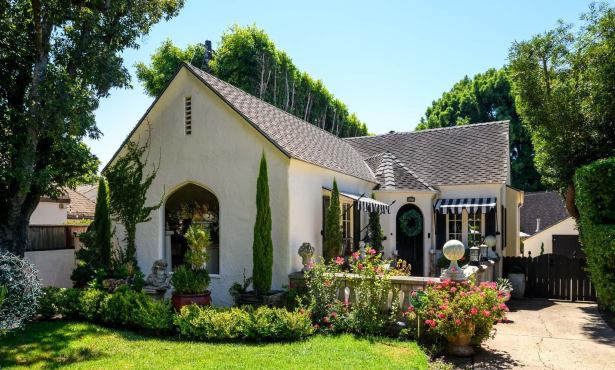H Is for Horticulture
Jan Scheinle’s name may be familiar to those who remember the
grueling, years-long battle to close the leaky toxic waste facility
in Casmalia. Scheinle, then a PhD student at UCSB, was instrumental
in closing the dump. Since then, she has taken an extended vacation
from political activism and has fiercely devoted herself to
teaching and studying horticulture, and acting as a docent at Lotus
Land, where Independent gardening columnist Virginia Hayes
is curator. When I reached Scheinle in her lab, she was celebrating
the news that her hometown hero, Green Bay quarterback Brett Favre,
is returning to the Packers for a 17th season. That put her in such
a fabulous mood that she agreed answer a few questions about
growing your own. Visit the Lifescape this year on Earth Day if you
have more questions for Scheinle, her colleagues, and students in
SBCC’s Environmental Horticulture Department.
I commonly see citrus, figs, avocados, and grapes in
Santa Barbara’s back yards. What other edible fruits easily grow
here?
Not to be too broad on this question, but almost anything grows
well in this Mediterranean environment that we enjoy here in SB. So
in addition to the fruit trees you already mentioned, pome fruits
such as selected varieties of apple and pear do well, stone fruits
such as peach and nectarine, nut trees such as macadamia, and
tropical plants such as cherimoya, mango and banana to list a
few.
Lots of shrubs and vines are great here, such as kiwi, and a
wide variety of berries, such as the cane berries, for example
blackberries and Olalla berries. Strawberries do well, and even
blueberries if the pH of the soil is lowered to accommodate them.
Some folks have pushed the margin a bit to grow cranberries
here.
I’m not sure if you want to talk about annuals here, but there
are the winter veggies, such as cabbage, cauliflower, broccoli,
Brussels sprouts and peas and beans.
Summer crops include tomatoes, peppers, squashes, melons,
onions.
And then there is the year-round herb garden.
Do all of these need significant soil amendments here in
Santa Barbara?
Only the blueberries in a major way. The rest are fine if it’s
not too heavy a clay soil. All of them need good drainage.
You’re kidding! By “in a major way” do you mean that for
the others I don’t have to dig a huge pit and fill it with potting
soil or mixed soil?
That is correct. In fact, typically you don’t want to make the
potting hole a too enriched or different environment from the rest
of the garden, because as the roots grow they may have a tendency
to stay in the rich special soil environment and not into the
surrounding area. Also the hole should not be much larger than the
root ball of the plant itself. The outer part of the hole should be
loosened up a bit to make it easier for roots to grow into. Of
course throwing in a few handfuls of organic compost helps most
plants except things like lavenders and sages that don’t like the
organic soils.
How do you know if your soil is too clay-ey for
this?
The soil can be checked in a field test where one would moisten
the soil and roll it between two hands to form a tube. If the soil
holds together tightly, forms a tube more than several inches that
holds together, and feels somewhat slick also, it is high in clay,
essentially a clay loam. If it holds together in a tube for several
inches and breaks apart it is more likely a silty loam, which is
the best condition. If it won’t pack into a tube and hold together
it is a sandy loam and will drain too fast for most plants. “Ideal
soil” is 40 percent sand, 40 percent silt, and 20 percent clay with
some organic material mixed in.
Are backyard gardens important as habitat? As I see
infill going on throughout the city—and as important as that is in
terms of landuse planning—I mourn about the loss of wildlife
habitat that back yards represent. Worms, insects,
birds.
Absolutely. It is very easy to integrate gardens that provide
food for mankind while at the same time providing food, shelter,
and nesting sites for the wildlife. It is also important to attract
a wide variety of pollinators to assure successful plant
reproduction and food production. In a small area you might use a
roof, a ledge, a raised bed; if you have a very small space you can
grow vines on trellises and arches. Citrus, bananas, and a variety
of cocktail plants [grafts] and dwarf varieties can be grown in
pots.
Here’s a sort of stinky question. Sewage sludge is
composted and used as fertilizer in California. So, if you pee on
your plants, is it good for them or not? And if you are a super
heavy duty recycling freak, can you compost pet and human
waste?
First, urinating on plants is not good in general. Many trees
survive dogs lifting their legs on plants here and there if a fire
hydrant is not available! But as a general rule, no, as urine is
too concentrated.
Second, solid waste from animals or humans needs to go through
the entire decomposition cycle, which will destroy pathogenic
microbes that may be present and recycle nutrients into the forms
needed by plants. It is in the finished compost product that it has
been thoroughly recycled. Used in the “fresh” state, it is too
concentrated, too high in nitrogen, and the potential for pathogens
is a risk factor.
If you wanted to do that, what percentage of, say, dog
poop would you recommend? Well, not that you would recommend it,
but what would work?
Almost all green and brown [dried plant] waste with a minimal
basis of animal manure. It will break all the way down, but it is
definitely not a huge component. In a three by three by three foot
compost pile, you might have no more than the equivalent of three
or four pounds of animal manure.



